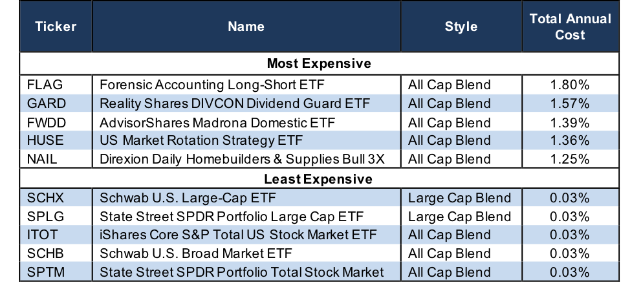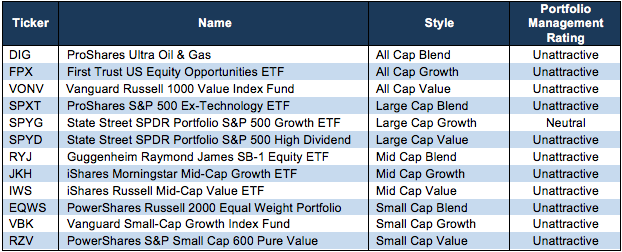How To Avoid The Worst Style ETFs 2Q18
David Trainer | Jun 26, 2018 09:28AM ET
Question: Why are there so many ETFs?
Answer: ETF providers tend to make lots of money on each ETF so they create more products to sell.
The large number of ETFs has little to do with serving your best interests. Below are three red flags you can use to avoid the worst ETFs:
- Inadequate Liquidity
This issue is the easiest issue to avoid, and our advice is simple. Avoid all ETFs with less than $100 million in assets. Low levels of liquidity can lead to a discrepancy between the price of the ETF and the underlying value of the securities it holds. Plus, low asset levels tend to mean lower volume in the ETF and larger bid-ask spreads.
- High Fees
ETFs should be cheap, but not all of them are. The first step here is to know what is cheap and expensive.
To ensure you are paying at or below average fees, invest only in ETFs with total annual costs below 0.46%, which is the average total annual cost of the 441 U.S. equity style ETFs we cover. The weighted average is lower at 0.15%, which highlights how investors tend to put their money in ETFs with low fees.
Figure 1 shows Forensic Accounting Long-Short ETF (NASDAQ:FLAG) is the most expensive style ETF and Schwab U.S. Large Cap ETF (NYSE:SCHX) is the least expensive. Exchange Traded Concepts Trust provides one of the most expensive ETFs while Schwab (SCHX, SCHB) and State Street (SPLG, SPTM) ETFs are among the cheapest.

Sources: New Constructs, LLC and company filings
Investors need not pay high fees for quality holdings[1]. Schwab U.S. Large Cap ETF (SCHX) is the best ranked style ETF in Figure 1. SCHX’s Neutral Portfolio Management rating and 0.03% total annual cost earns it an Attractive rating[2]. Alpha Architect U.S. Quantitative Value ETF (NYSE:QVAL) is the best ranked style ETF overall. QVAL’s Attractive Portfolio Management rating and 0.88% total annual cost earns it a Very Attractive rating.
On the other hand, State Street SPDR Portfolio S&P 500 High Dividend ETF (NYSE:SPYD) holds poor stocks and earns our Unattractive rating, yet has low total annual costs of 0.08%. No matter how cheap an ETF, if it holds bad stocks, its performance will be bad. The quality of an ETFs holdings matters more than its price.
- Poor Holdings
Avoiding poor holdings is by far the hardest part of avoid bad ETFs, but it is also the most important because an ETFs performance is determined more by its holdings than its costs. Figure 2 shows the ETFs within each style with the worst holdings or portfolio management ratings.

Sources: New Constructs, LLC and company filings
iShares (NYSE:JKH), (NYSE:IWS), PowerShares (NYSE:EQWS, RZV), ProShares (NYSE:SPXT), (NYSE:DIG), State Street (NYSE:SPYG, (NYSE:SPYD), and Vanguard (NYSE:VBK, (NASDAQ:VONV) appear more often than any other providers in Figure 2, which means that they offer the most ETFs with the worst holdings.
ProShares Ultra Oil & Gas (DIG) is the worst rated ETF in Figure 2. Guggenheim Raymond James SB-1 Equity ETF (RYJ), Vanguard Small Cap Growth Index Fund (VBK), iShares Morningstar Mid Cap Growth ETF (JKH), PowerShares Russell 2000 Equal Weight (EQWS), PowerShares S&P Small Cap 600 Pure Value (RZV), iShares Russell Mid Cap Value ETF (IWS) and State Street SPDR Portfolio S&P 500 High Dividend ETF (SPYD) earn an Unattractive predictive overall rating, which means not only do they hold poor stocks, they charge high total annual costs.
Our overall ratings on ETFs are on our stock ratings of their holdings and the total annual costs of investing in the fund.
The Danger Within
Buying an ETF without analyzing its holdings is like buying a stock without analyzing its business and finances. Put another way, research on ETF holdings is necessary due diligence because an ETF’s performance is only as good as its holdings’ performance. Don’t just take our word for it, see what Barron’s says on this matter.
PERFORMANCE OF ETFs HOLDINGs = PERFORMANCE OF ETF
Analyzing each holding within funds is no small task. Our Robo-Analyst technology enables us to perform this diligence with scale and provide the research needed to fulfill the fiduciary duty of care. More of the biggest names in the financial industry (see At BlackRock, Machines Are Rising Over Managers to Pick Stocks) are now embracing technology to leverage machines in the investment research process. Technology may be the only solution to the dual mandate for research: cut costs and fulfill the fiduciary duty of care. Investors, clients, advisors and analysts deserve the latest in technology to get the diligence required to make prudent investment decisions.
Disclosure: David Trainer and Kyle Guske II receive no compensation to write about any specific stock, style, or theme.
Trading in financial instruments and/or cryptocurrencies involves high risks including the risk of losing some, or all, of your investment amount, and may not be suitable for all investors. Prices of cryptocurrencies are extremely volatile and may be affected by external factors such as financial, regulatory or political events. Trading on margin increases the financial risks.
Before deciding to trade in financial instrument or cryptocurrencies you should be fully informed of the risks and costs associated with trading the financial markets, carefully consider your investment objectives, level of experience, and risk appetite, and seek professional advice where needed.
Fusion Media would like to remind you that the data contained in this website is not necessarily real-time nor accurate. The data and prices on the website are not necessarily provided by any market or exchange, but may be provided by market makers, and so prices may not be accurate and may differ from the actual price at any given market, meaning prices are indicative and not appropriate for trading purposes. Fusion Media and any provider of the data contained in this website will not accept liability for any loss or damage as a result of your trading, or your reliance on the information contained within this website.
It is prohibited to use, store, reproduce, display, modify, transmit or distribute the data contained in this website without the explicit prior written permission of Fusion Media and/or the data provider. All intellectual property rights are reserved by the providers and/or the exchange providing the data contained in this website.
Fusion Media may be compensated by the advertisers that appear on the website, based on your interaction with the advertisements or advertisers.